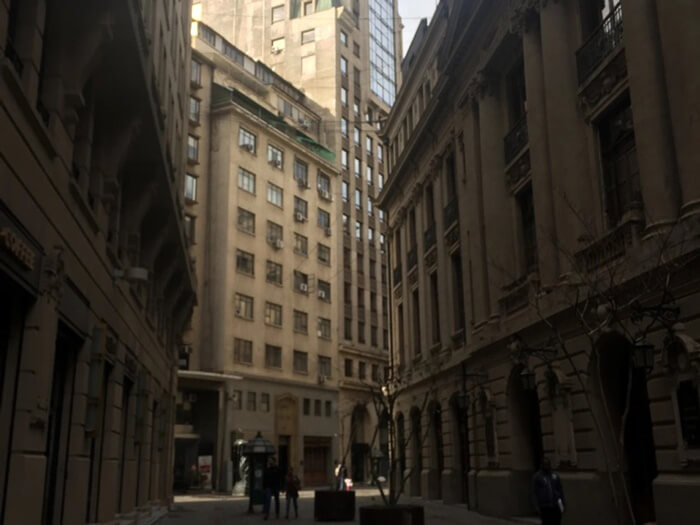(Note: Some links originally shared in 2019 are no longer active.)
Hola everyone! Thank you for following the 2019 GW UNESCO Fellows blog! As of this week, I am celebrating one month being in Chile, and will be completing my three month fellowship in August. This summer I am very fortunate interning at the UNESCO Regional Bureau for Education in Latin America and the Caribbean (OREALC/UNESCO Santiago).
The regional office that I am interning this summer focuses on the Education 2030 Agenda for Sustainable Development — it is a universal agenda that aims to eradicate poverty by 2030. For the past month, I have supported the Education 2030 Agenda coordination team, assisting on various projects targeting Sustainable Development Goal 4.

The title of this post references the UNESCO 2019 Global Education Monitoring (GEM) Report, called “Building Bridges, Not Walls.” This report was one of the first publications I read at the office. The 2019 GEM Report presents evidence of the implications and challenges that are posed by migration in education systems. These issues are addressed in the projects I am assisting at the UNESCO Santiago office.
In an age of global migration, the situation in the Latin America and the Caribbean region is in dire need for spaces of protection, such as a safe place to live and the right to an education. According to the United Nations High Commissioner for Refugees (UNHCR), the number of people fleeing violence, political instability, and persecution doubled in Central America. It was reported that in 2019, 593,507 asylum-seekers and migrants have arrived at the southern U.S. border from Mexico. Over the past decade alone, an increase in Haitian and Dominican migration to countries in Latin America is notable, and is very much present in Santiago. As of June 2019, the UN reported that an estimated 4 million Venezuelans have fled the country — this is about 10 percent of the country’s population.
As a response to this ongoing humanitarian crisis in the region, the UNESCO Regional Strategy for People on the Move was created. It is a regional response and framework which is meant to support countries’ efforts to guarantee the right to education of people in a context of mobility.

gives technical support to the Ecuadorian national strategy”
During my time here, I am particularly assisting the various activities of the Regional Strategy for People on the Move. I was able to attend one of the meetings of the Regional Inter-agency Coordination Platform for Refugees and Migrants from Venezuela, which was established by the UNHCR and the International Organization for Migration (IOM). In attendance were various UN agencies, government representatives, and NGOs. I was able to observe how inter-agency collaboration works and the implementation process of an emergency operational response at both the national and regional level.
I recently started to translate media which highlight UNESCO´s efforts to support education response strategies in Latin America and the Caribbean to meet the needs of people on the move. For instance, I translated an interview on UNESCO Santiago’s role in supporting the Ministry of Education of Ecuador in their development of a national strategy for migrants.
I am also currently working with another intern, GW UNESCO Fellow, Maggie! (shout out to Maggie for being amazing, keep on the lookout for her updates on this project soon!) We have started to work together to support a Global Citizenship Education (GCE) regional policy brief proposal. The proposal aims to analyze and evaluate how GCE, with an emphasis on human rights, can aid the integration and social inclusion inside and outside the classroom of migrant children.
Being part of this regional work has a great significance to me. As a daughter of immigrants, whose parents came to the US from Mexico in the late 1980s, advocacy for displaced communities is something deeply rooted in me — for those of you who know me personally, it is embedded as part of my identity as a scholar-practitioner and a community advocate. I look forward in using the knowledge I have learned at UNESCO Sanitago after this internship is completed and continue to push for immigration advocacy back in the US.

Besides intern life in the office, I have explored this wonderful city I have called home for the past month. Santiago has many cultural institutions commemorating Chilean heritage. So far I have visited the Chilean National Museum of Fine Arts, La Chascona / Pablo Neruda Foundation, the Chilean Museum of Pre-Columbian Arts, and many other historic sites. Recently, I visited the Museum of Memory and Human Rights to attend a series of community-led talks called “El Derecho Humano a Ser Migrantes” (The Human Right to be Migrants).




This is my first time in South America and overall I have been thoroughly enjoying the diverse food, culture, music, art, and picturesque views of the area. Walking around the city, I am still amazed that I am actually here. I am grateful for this experience and look forward to the rest of this summer here in Chile. Thank you for reading and I will be posting later on this summer! Hasta luego!

Renny is a Master’s candidate in International Education with a focus on conflict, security, and peacebuilding at the George Washington University’s Graduate School of Education and Human Development.


